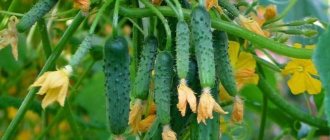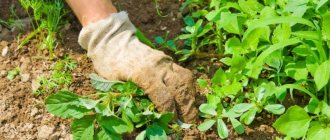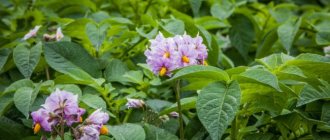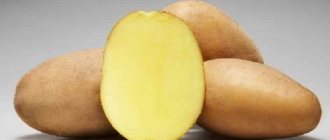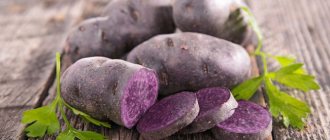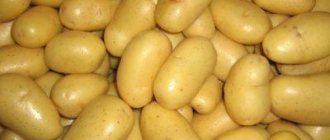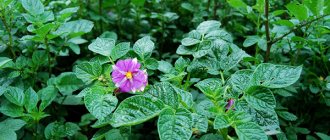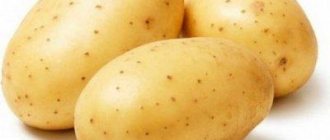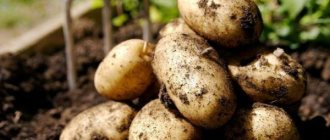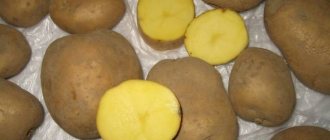Vegetable growing » Potatoes
0
1329
Article rating
Kira Stoletova
Natasha potatoes are promising and highly productive. Although it was bred relatively recently, this did not prevent it from winning the sympathy of a large number of gardeners and summer residents. It has become increasingly popular lately, and deservedly so. A description of the crop allows you to be convinced of its merits and visible advantages over other varieties.
Characteristics of potato variety Natasha
More about the variety
Potato bushes do not grow too tall. They have an erect intermediate type. Large leaves have a slight waviness. The tops are light or dark green. The whitish flowers are endowed with a noticeable blue with bright yellow pistils.
Varietal potatoes are medium-sized, oval in shape. The root vegetables in the tubers are smooth, covered with even skin. In rare cases, clumsiness occurs. The light yellow potato skin is covered in places with almost invisible eyes.
The weight of one fruit ranges from 95–140 g. At the cut site, you can see delicate pulp of a uniform dark yellow color. Potatoes of the Natasha variety are valued for their high starch content. As a rule, the percentage is 11–13.6%.
Growing
The site on which the Natasha potato variety will be planted is prepared in the fall. The soil is dug up deeply and saturated with mineral and organic fertilizers. Organics are added in the following way:
- sandy soil - peat, rotted manure and clay (all 10 kg);
- clay soil - 10 kg of peat (humus);
- peat soil - sand, clay, rotted manure (1 bucket of each substance).
If there is no humus, it is replaced with bird droppings. 200 g are diluted in warm water and watered over the land. Regardless of the above actions, it is mandatory to add 200 g of wood ash, 20 g of superphosphate and 10 g of potassium fertilizer. 1 m of acidic soil where potatoes will be planted is slaked with 200 g of lime.
In the spring, the land for potatoes is dug up again. Remove weeds. When planting a potato variety, add 5 tablespoons of wood ash and 400 g of humus into the hole. It is sprinkled with earth so that it does not burn the root vegetables.
Agricultural technology
Small potatoes weighing from 30 to 60 grams are selected as planting material.
Before planting, the tubers are thoroughly inspected for mechanical damage and diseases. Damaged potatoes should not be planted in the soil. For large planting areas, a potato planter or cultivator is used. In a small area, it is better to use the manual planting method, using a bayonet shovel to prepare the holes. Potatoes are planted in small holes with a diameter of 10 to 15 cm and a depth of no more than 20 cm. Since the bushes are voluminous, an equal distance of 40 cm is maintained between the cells, and 60 cm between the beds. Thanks to this technique, the tubers receive the maximum amount of moisture and sun rays. 500 g of fermented manure and 200 g of stove ash are added to each cell. Place no more than 2 tubers in one hole, sprinkle with sifted soil and water a little. Once planting is completed, the soil is well leveled with a rake to avoid the appearance of a hard crust on the ground.
As was written earlier, the tuber culture has a high immunity to fungal and infectious diseases, and also favorably tolerates temperature changes in open ground. By applying basic agrotechnical methods, gardeners will be able to achieve high yields even from a small plot:
- Regular weeding. Three days after planting the potatoes, the soil is loosened again with a rake. This will not only prevent the top layer of soil from becoming coarse, but will also help remove unnecessary weeds.
- If frosts are possible, young bushes must be completely covered with earth.
- If the soil was well fed in the fall, then there is no need to apply additional fertilizers for the development of tubers.
- It is not recommended to water the plants often, since the variety tolerates dry days well, and an excess of moisture can lead to rotting of the tubers.
- Constantly inspect the tops for the presence of pests or diseases.
It is better to harvest potatoes in sunny and warm weather in order to be able to “roast” the crop in the sun. Some gardeners recommend cutting off the tops before harvesting tubers to prevent the risk of contamination of the product with various fungal diseases. This is strictly forbidden, since after cutting the tops, the tubers become very hard.
Before storing, Natasha potatoes must be left for two days in a dry and dark room. Next, the tubers are thoroughly inspected and selected for sowing and nutrition. It is better to store potatoes in large wooden containers so that air can fully circulate from all sides.
Potato Natasha is a table type of tuber crop. They have good culinary characteristics and a pleasant taste. Due to the high starch content, the tubers turn out crumbly. Potatoes are ideal for frying, stewing, and preparing salads, since under the influence of high temperatures they do not change their shape and consistency.
Alexey, 42 years old, Ukraine
Natasha liked the potatoes solely because of their taste. Despite the fact that the summer turned out to be hot and dry, the harvest turned out to be quite good. Most often, 15-20 potatoes were dug into holes. The average weight of one tuber was 110 g. When cut, the flesh is richly yellow and dense. This year I’m also thinking of planting this variety.
Anton, 44 years old, Moscow region
I have been cultivating the Natasha variety for more than five years. I first heard about potatoes from my neighbor. I asked him for 10 pieces and planted them on my small plot. At the end of the season, I collected from 17 to 22 potatoes from each hole. Now I grow only this variety every year.
https://fermilon.ru/sad-i-ogorod/ovoshhi/kartofel-natasha.html
https://osortah.ru/kartofel/natasha.html
Landing
It is carried out according to the principles of planting early crops. Tubers are removed from storage at the end of winter for acclimatization. If necessary, they are sorted out. Medium-sized tubers that are not damaged must be germinated.
See also
Application of Precipitate fertilizer and its benefits for plantsRead
For quick and effective germination of potato varieties, sufficient lighting is provided. After sprouts have appeared, the potatoes are treated with growth stimulants. This could be “Hercules” or any other product purchased in a specialty store. To protect potato planting material, it is sprayed with another preparation - “Prestige”.
General landing rules
To effectively plant vegetables, follow simple rules:
- On a small plot of land they use a shovel, on large plots they use a potato planter. In the first case, an ordinary bayonet shovel is suitable, which is easy to make holes.
- There is no need to bury potato tubers, as this creates inconvenience when digging. After hilling, a ridge will appear on top.
- The distance between holes is 30–35 cm. Between rows is no more than 70 cm.
The spacing parameters ensure uniform heating of the soil and the availability of lighting that the potatoes need. The variety germinates well, as evidenced by the large bushes. This distance makes it easy to remove weeds and hill up the plant. A fully planted potato plot is leveled using a rake or harrow.
Features of care
During the growing season, potatoes compare favorably with most early varieties in their resistance to adverse environmental conditions. Modern agrotechnical techniques make it possible to create a high-quality potato harvest. Among the total number are:
- Before the sprouts appear, the land area is cleared of weeds, preventing the formation of an earthen crust on the surface. Otherwise, it interferes with aeration, cutting off the access of oxygen to the roots of the plant.
- To protect the seedlings from late frosts, the first hilling of potato tops is carried out. By completely covering the sprouts with soil, they prevent the appearance of weeds and retain moisture in the ground.
- If the soil has been enriched with fertilizers since the fall, and additional amounts of them are added during planting of potatoes, only two additional feedings are required during the season of growth and development. One of them is foliar.
- Measures to care for the potato variety, including irrigation, contribute to the full formation of tubers. In this regard, caution should be exercised, since excess moisture causes crop rot. Questions about watering are handled carefully.
Despite following the rules of cultivation and care, it is necessary to periodically inspect potato tops. A number of factors can contribute to pest attack and disease development in potatoes. If the first signs of the disease are noticed, a number of protective measures must be taken. They include treating plants with insecticidal and fungicidal preparations.
See also
Description of the Rosara potato variety, recommendations for growing and reviews from gardenersRead
Advantages and disadvantages
The potato variety is not as widely used as others, as it was registered in the country's registry not so long ago. The description of the variety indicates a significant number of advantages. By planting potatoes, the agronomist receives the following:
- marketability of root crops from 70 to 95%;
- a large number of tubers in one bush;
- early yield;
- high percentage of yield;
- impeccable taste of the pulp;
- keeping quality of tubers during long-term storage.
During storage, 5 to 7% of the potato mass spoils from the total harvest. The fruits of this variety have high taste and impeccable appearance. The variety does not have any obvious disadvantages that should be taken into account. Moreover, it does not lose its shape when boiling or frying.
Productivity
High yield rates are genetically inherent in this variety.
Commercial yields remain at the level of 130 - 190 centners per hectare, which is 30 - 40 centners higher than the standard Udacha and Rozara varieties for the region. The maximum yield was collected within 320 c/ha, which is 80 c/ha higher than the standard. The yield of any potato is directly related to soil fertility. It would be naive to believe that if a variety is genetically programmed for productivity, it can bear fruit abundantly on poor soils.
Potato is a crop that produces a high removal of nutrients from the soil. And in order for it to show its productivity, it is necessary to have a high nutritional value of the land.
Experienced vegetable growers apply organic fertilizers to potatoes annually. This is the only way to increase fertility, provide the crop with nutrients and mineral elements, and humus compounds will balance all substances and make them available for consumption by the crop.
If there is no access to organic matter, vegetable growers use mineral fertilizers, which lead not to fertility, but to mineralization of the soil. An alternative to good organic fertilizers, humus of animal origin, is compost. Every gardener can prepare it by simply building a compost bin on his or her own plot. But the benefits from compost will be much greater than from mineral “sprinkling”.
Pests and diseases
The characteristics of the vegetable indicate the high protective properties of the immune system. This makes the potatoes immune to pests. The vegetable is resistant to many diseases, including potato canker, Y-virus, rhizoctonia, tuberous rot, and golden cyst nematode. This feature is provided by the protective properties of the immune system.
Harvest and storage
Experienced gardeners cut off the tops before digging up root crops in order to prevent the disease from entering the tubers. In this case, the potato skin becomes rougher and the flesh denser. Under no circumstances should you delay collecting tubers. The best period is a sunny day.
Before long-term winter storage, vegetables are kept in a dark and dry room. Potatoes are sorted for seeds and nutrition. Potato variety Natasha is stored in a basement or cellar in wooden boxes or nylon bags. If these are boxes, they are placed in stacks filled with potato mass.
Conditions for proper wintering
Potatoes of this variety tolerate winter well.
The safety of tubers is 93%. Careful preparation of tubers for storage: washing, drying, selection of damaged material increases this figure by another 2 - 3%. After digging, the potatoes are laid out in a thin layer to dry, but protected from direct sunlight. But the one that is selected as planting material, on the contrary, is taken out to warm up in the sun. For planting, you should select potatoes weighing 80 - 90 g. A special feature of the Natasha variety is that the eyes are located on one of the poles. Experienced vegetable growers sometimes cut off the “noses” and use them for planting, and the rest for culinary purposes. Such an event can be held both in autumn and spring. Whenever you decide to cut, you must allow time for the wounded surface of the tuber to scar.
Some potato growers, having conducted their personal research, prove that there is no need for scarring; potatoes grow well without healing.
Experienced vegetable growers recommend sampling three times with an interval of 1 - 2 weeks before sending tubers for storage. Such an event allows you to identify damaged, diseased tubers, which will be an additional guarantee of the safe preservation of the crop.
Potatoes "Natasha" have established themselves as a high-yielding, picky, and disease-resistant variety. German breeders gave the world potatoes that have taken root not only in Europe, but also in other countries. By planting this variety, creating conditions for soil fertility, and carrying out the necessary agrotechnical operations, you can get an excellent harvest of a tasty and nutritious product.
Gardeners about potato varieties
If gardeners are in doubt about whether to try planting a variety of German selection on their plot, they should turn to experienced summer residents. In general, reviews about Natasha’s potatoes are only positive.
A vegetable that produces a large number of tubers is suitable for frying, boiling, stewing and baking. Many are attracted by the color of its pulp and rich potato taste.
Annual planting does not affect the yield of tubers in any way. The only thing is that you need to change the landing site. Shoots appear quickly, so you can soon enjoy fresh new potatoes. To ensure that the harvest is always pleasing to the eye, you need to follow the rules of planting, care and harvesting.
Resistance to pathogens
Potato "Natasha", characteristics of the variety, reviews indicate that the variety is extremely resistant to potato cancer.
If the golden cyst nematode is rampant in the area, then this variety will be a godsend. It is enough to select a few more varieties of medium and late ripening, and you will forget about the problem with the pathogen for a long time.
The variety is moderately resistant to late blight. With temperature changes and cold morning dew, a riot of late blight fungus is inevitable, so it is necessary to carefully monitor the condition of the leaf apparatus and take action at the first sign.
Modern complex preparations used against microscopic fungus are quite effective and 2-3 treatments are enough for late blight to stop working.
